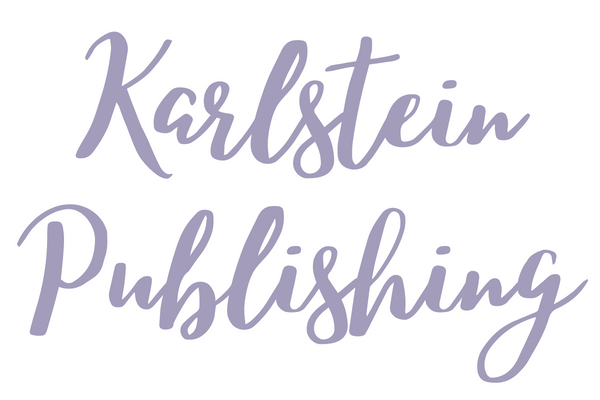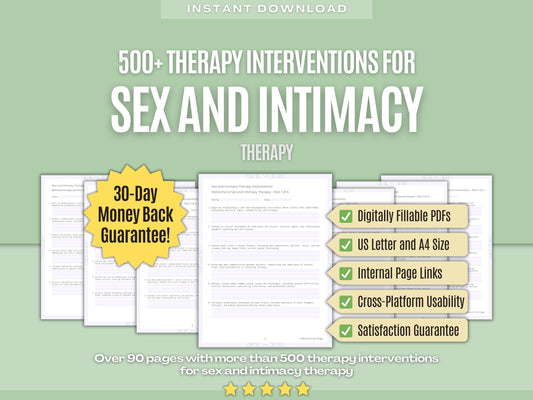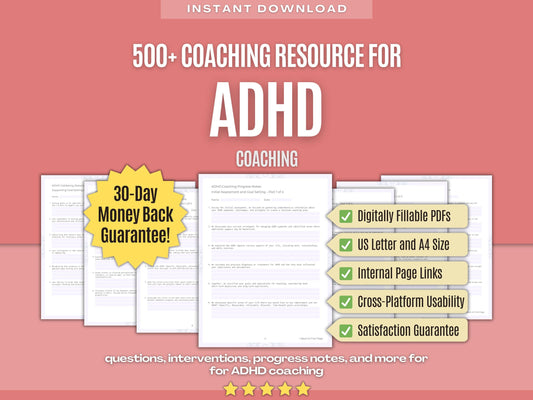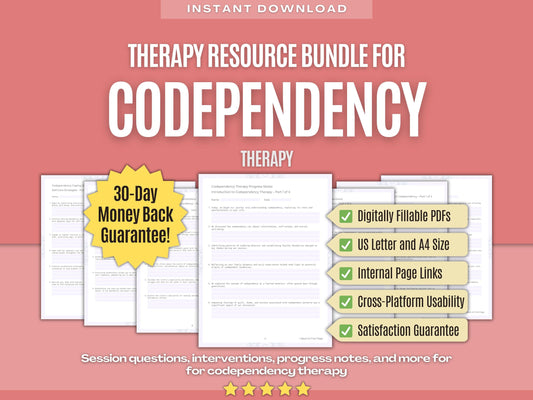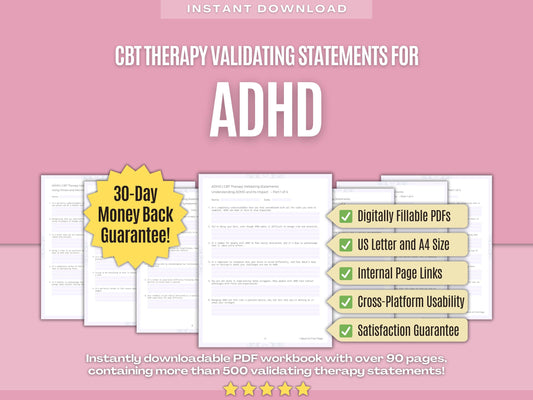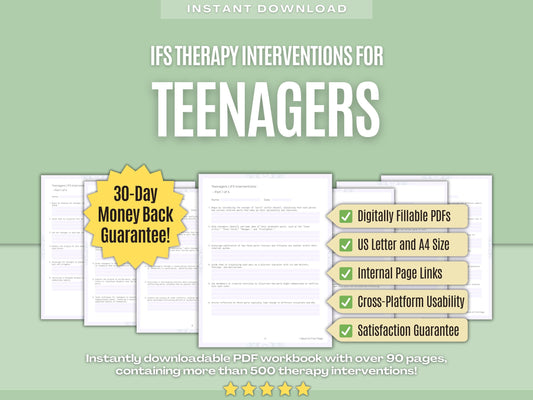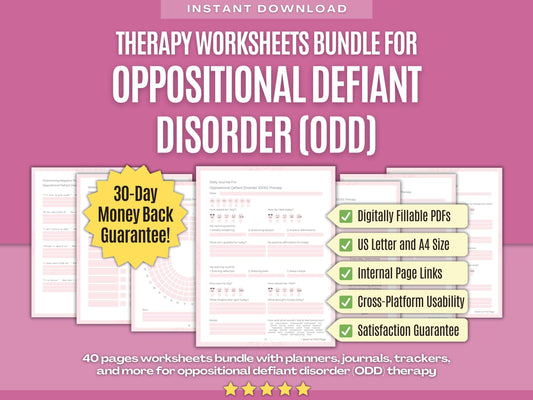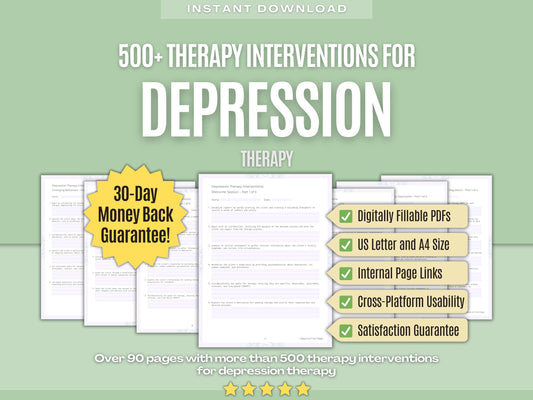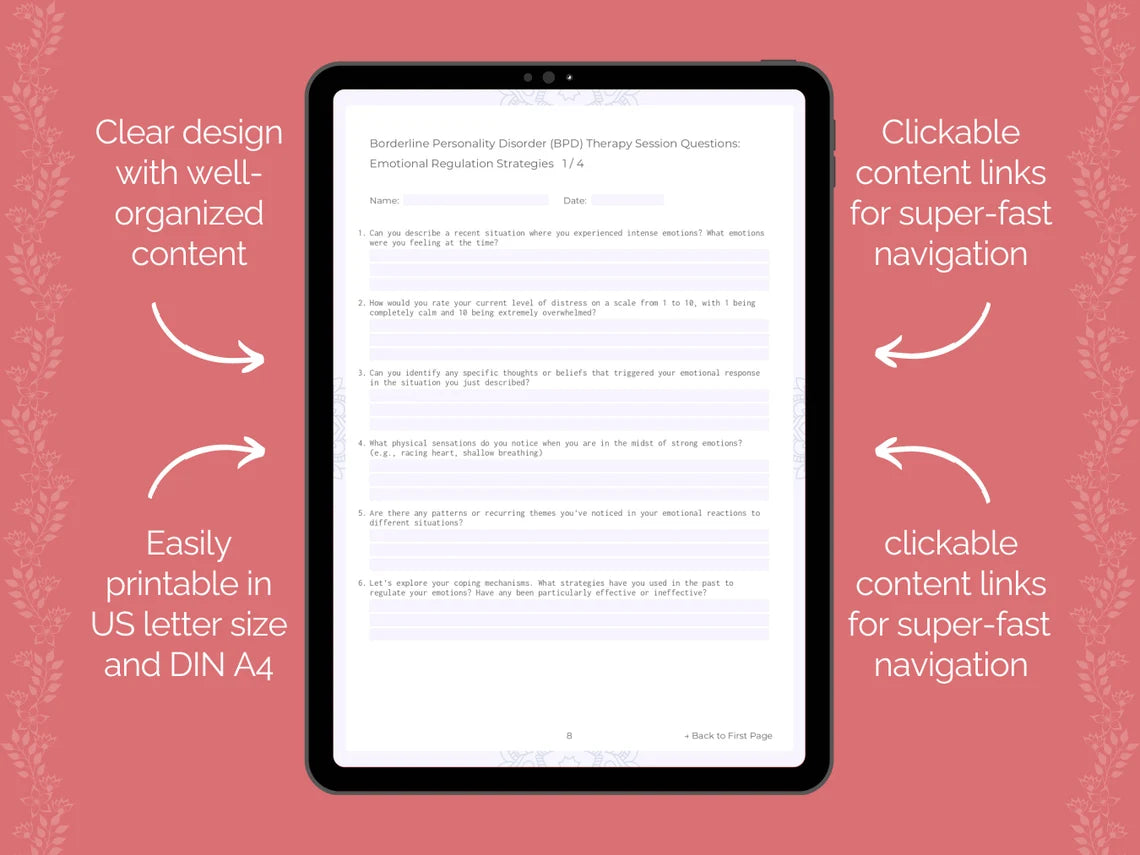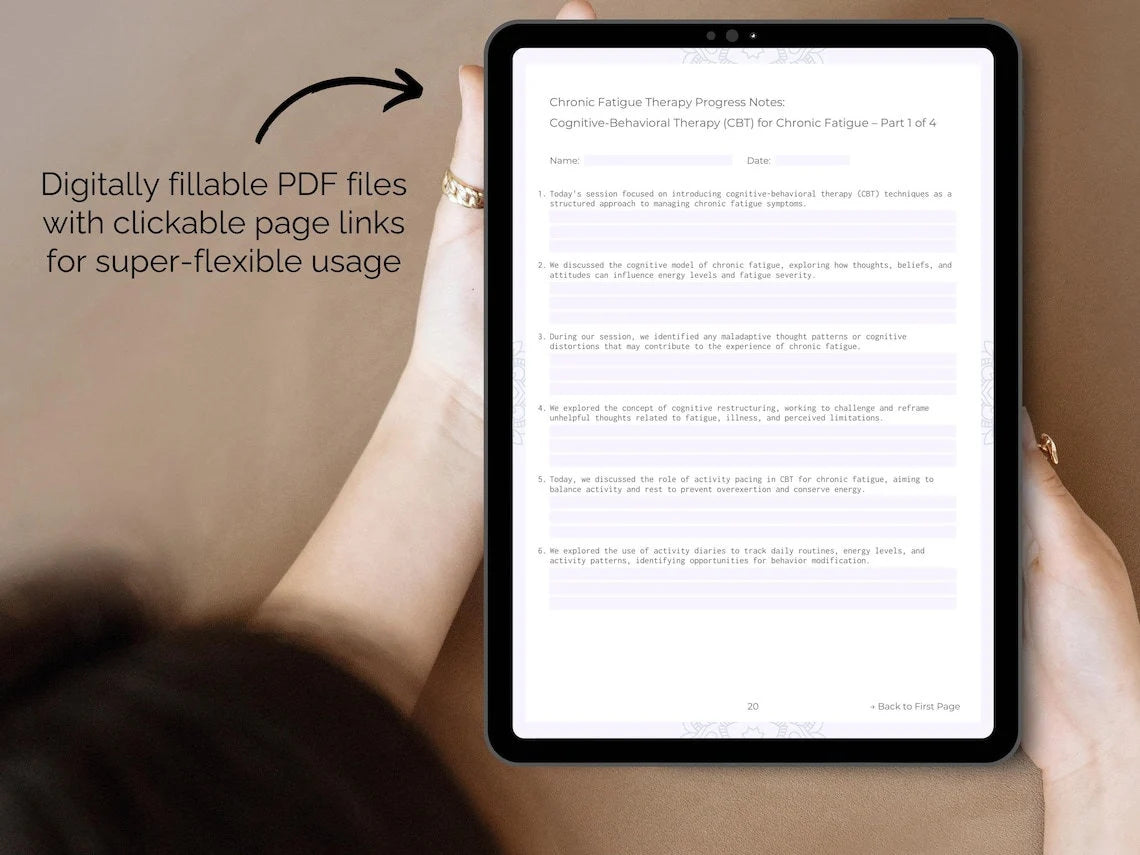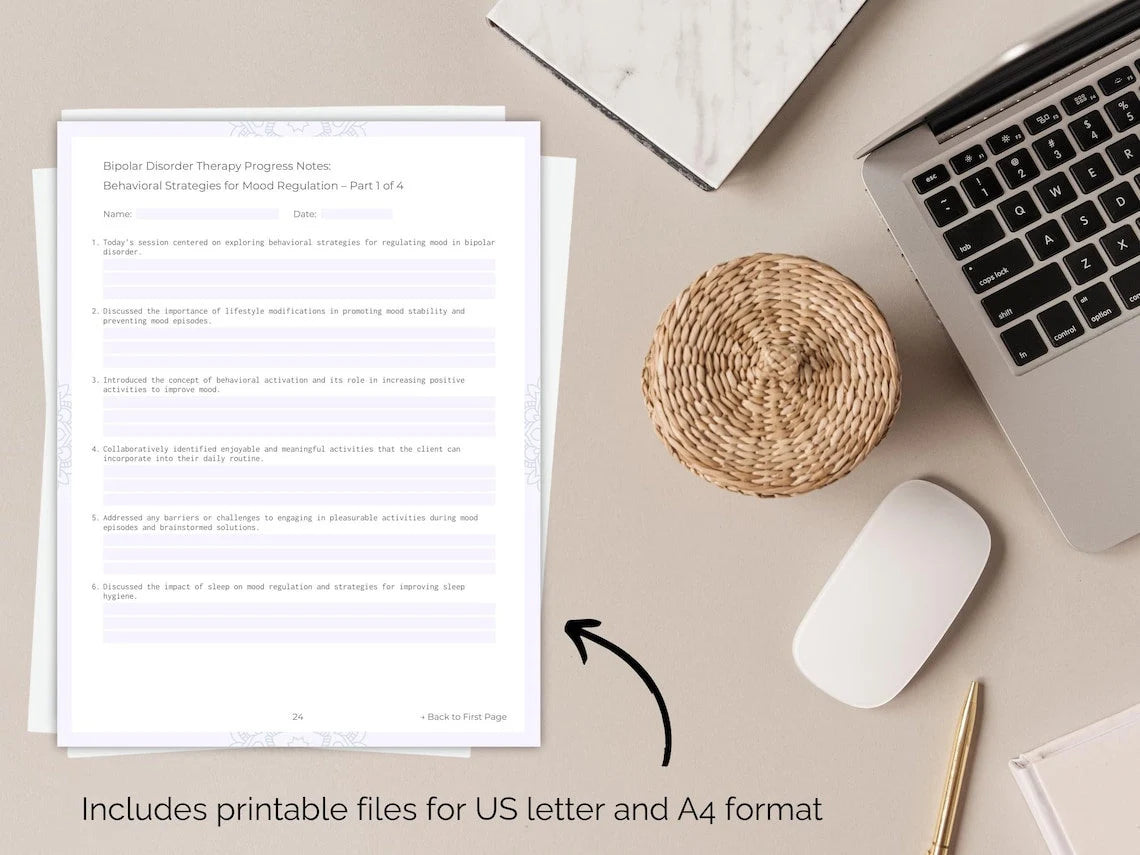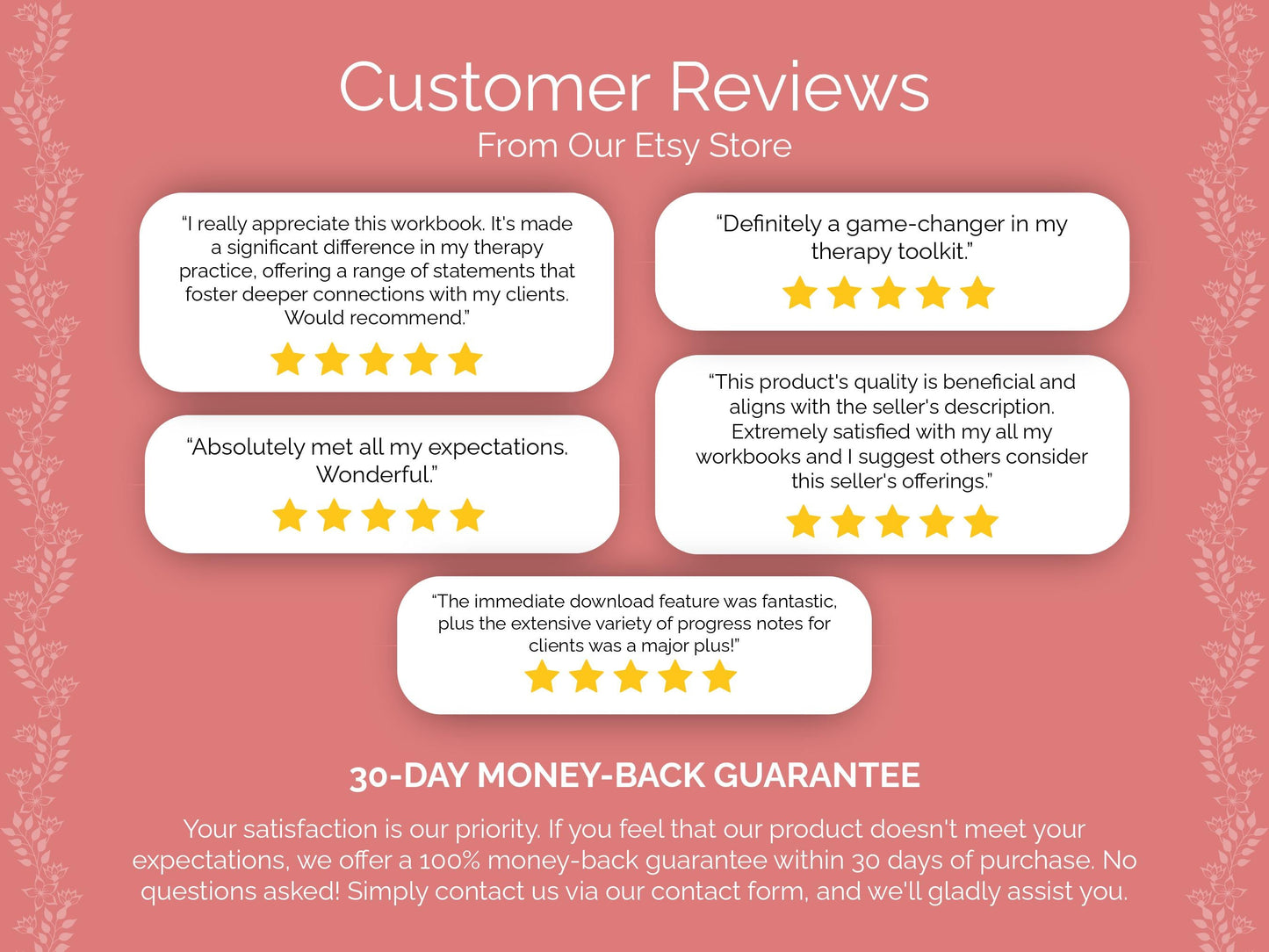Elevate Your Therapy and Guide Your Clients to Inner Healing with Our Burnout and Prevention Therapy Progress Notes! ✨
1. Starting Burnout Prevention Therapy
- The client attended their first session for burnout prevention therapy, expressing a desire to proactively address stressors before they escalate.
- The client disclosed a history of high stress levels and burnout episodes, indicating a pattern of neglecting their own well-being in favor of work obligations.
- The therapist and client collaboratively established therapeutic goals, including building resilience, setting boundaries, and improving self-care practices.
- Psychoeducation about the physiological and psychological effects of chronic stress was provided, helping the client understand the importance of burnout prevention strategies.
- A discussion about the client's support network revealed opportunities for strengthening social connections and seeking assistance when needed.
- It was noted that the client had some existing coping strategies in place but was open to exploring additional tools to enhance their resilience.
- The client was receptive to the idea of implementing regular self-assessment practices to monitor their stress levels and identify early warning signs of burnout.
- The client agreed to track their progress between sessions, noting any changes in their mood, energy levels, or stress levels.
- The client expressed a commitment to prioritizing their well-being and recognized the need for ongoing effort to sustain positive changes.
- The therapist provided resources for the client to explore outside of therapy, including books, articles, and online courses related to burnout prevention.
- The client was encouraged to celebrate small victories and acknowledge their progress, even when setbacks occur.
2. Burnout Psychoeducation
- The client attended a session focused on burnout psychoeducation, aimed at increasing their understanding of the phenomenon and its underlying causes.
- Discussions centered around the three dimensions of burnout: emotional exhaustion, depersonalization, and reduced personal accomplishment.
- Depersonalization was explained as the development of negative, cynical attitudes and behaviors towards clients, colleagues, or work tasks.
- It was discussed that burnout can impact various aspects of an individual's life, including physical health, relationships, and overall well-being.
- The therapist outlined common risk factors for burnout, such as high job demands, low job control, lack of social support, and poor work-life balance.
- The therapist discussed the importance of early recognition and intervention in preventing burnout from escalating to more severe mental health issues.
- The therapist addressed misconceptions about burnout, such as viewing it solely as a sign of personal failure or weakness.
- The client gained insight into the cyclical nature of burnout, with prolonged stress leading to depletion of resources and increased vulnerability.
- Strategies for burnout prevention were discussed, including stress management techniques, setting boundaries, and seeking social support.
- The therapist provided resources for further reading and self-study on burnout, resilience, and stress management.
- The therapist reassured the client that gaining knowledge about burnout is an important first step towards regaining control and resilience.
3. Mindfulness for Stress Reduction
- The client engaged in a session focusing on mindfulness techniques for stress reduction, aiming to cultivate present-moment awareness and non-judgmental acceptance.
- The client learned various mindfulness exercises, including deep breathing, body scans, and mindful walking, to anchor their attention to the present moment.
- The client expressed curiosity about integrating mindfulness into their daily life to manage stressors more effectively.
- The client reported feeling more grounded and centered after the deep breathing exercise, noting a reduction in racing thoughts and physical tension.
- The therapist discussed the role of automatic thoughts and habitual reactions in perpetuating stress and explored how mindfulness can interrupt these patterns.
- It was noted that mindfulness can help individuals develop greater resilience in the face of adversity by fostering a sense of inner strength and resourcefulness.
- The therapist addressed common challenges in maintaining a regular mindfulness practice, such as finding time and overcoming resistance.
- The client shared their experiences with practicing mindfulness outside of therapy, noting moments of increased calmness and clarity in stressful situations.
- It was acknowledged that mindfulness is a skill that requires patience and practice, and progress may not always be linear.
- The therapist provided resources for further exploration of mindfulness, including guided meditations, books, and smartphone applications.
- The client expressed gratitude for the transformative potential of mindfulness in their life and a commitment to continuing their practice.
4. Dialectical Behavior Therapy (DBT) for Emotional Regulation
- The client engaged in a session focused on Dialectical Behavior Therapy (DBT) techniques for emotional regulation, aiming to develop skills to manage intense emotions associated with burnout.
- The client learned about the function of emotions and how they can serve as valuable information about one's internal experience and needs.
- The client expressed a desire to learn practical strategies for tolerating distress and responding to emotions in a more balanced and constructive way.
- The client practiced mindfulness exercises to increase awareness of their emotional states and cultivate a sense of acceptance and non-reactivity.
- The therapist introduced the skill of emotion regulation, focusing on strategies for identifying and modulating emotions to achieve a balanced emotional state.
- It was discussed that emotion regulation skills can help prevent escalation of emotional distress and promote a sense of control and well-being.
- The therapist provided worksheets and handouts to support the client in practicing emotion regulation techniques between sessions.
- It was acknowledged that mastering emotion regulation skills takes time and practice, and the client was encouraged to be patient and persistent in their efforts.
- The client learned skills such as distraction, self-soothing, and radical acceptance to tolerate distressing emotions and situations.
- The client expressed a commitment to practicing distress tolerance techniques regularly, noting their potential to improve coping and resilience in the face of stress.
- A plan for ongoing practice and review of DBT skills was established, with the client committing to integrating them into their daily life and seeking support as needed.
5. Interpersonal Therapy (IPT) for Workplace Relationships
- The client engaged in a session focused on Interpersonal Therapy (IPT) techniques for addressing workplace relationships, aiming to explore and improve interpersonal dynamics contributing to burnout.
- The client learned that IPT focuses on identifying and addressing specific interpersonal problems or conflicts that may be contributing to distress.
- The client expressed a desire to explore their interpersonal experiences in the workplace and identify strategies for improving communication and relationship dynamics.
- The client reported feeling validated and understood as they shared their experiences of navigating interpersonal challenges in the workplace.
- The therapist introduced the four interpersonal problem areas targeted in IPT: grief, interpersonal role disputes, role transitions, and interpersonal deficits.
- It was discussed that addressing interpersonal problems can lead to improved communication, increased support, and a greater sense of satisfaction in the workplace.
- The therapist provided psychoeducation about effective communication skills, boundary setting, and assertiveness techniques to help address interpersonal challenges.
- It was acknowledged that developing assertiveness skills can empower the client to advocate for themselves and navigate workplace relationships with confidence.
- The client reported feeling more prepared and confident to apply assertiveness techniques in real-life workplace situations.
- The therapist provided strategies for building social support networks within the workplace, such as seeking out mentors, joining professional networks, or forming peer support groups.
- A plan for ongoing practice and review of interpersonal skills was established, with the client committing to regular self-assessment and reflection on their workplace interactions.
6. Emotion-Focused Therapy (EFT) for Emotional Awareness
- The client engaged in a session focused on Emotion-Focused Therapy (EFT) techniques for developing emotional awareness, aimed at exploring and processing underlying emotions contributing to burnout.
- The client learned that EFT views emotions as valuable sources of information, guiding individuals towards greater self-understanding and authentic expression.
- The client expressed a desire to deepen their emotional awareness, learn to identify and label their emotions more accurately, and develop healthier ways of coping.
- The client reported feeling more connected to their emotional experience as they engaged in exercises to identify and name their emotions without judgment.
- The therapist introduced the concept of emotional differentiation, which involves discerning between subtle nuances of emotions and understanding their underlying causes.
- It was discussed that emotional differentiation can facilitate more adaptive coping strategies and prevent emotional overwhelm or numbing.
- The therapist provided techniques for processing and expressing emotions, such as journaling, guided imagery, and expressive arts therapies.
- It was acknowledged that expressing emotions in a safe and supportive environment can promote emotional release, insight, and healing.
- The client reported feeling validated and understood as they shared their emotional struggles and vulnerabilities in therapy.
- The therapist provided psychoeducation about the function of emotions and their adaptive role in navigating interpersonal relationships and life challenges.
- A plan for integrating emotional awareness practices into daily life was established, with the client committing to regular self-reflection, mindfulness, and emotional check-ins.
7. Psychodynamic Approaches for Deep Emotional Insight
- The client engaged in a session focused on Psychodynamic Approaches for Deep Emotional Insight, aimed at exploring unconscious conflicts, relational patterns, and early life experiences contributing to burnout.
- The client learned that psychodynamic therapy seeks to uncover and work through unconscious conflicts and unresolved issues that may be contributing to symptoms such as burnout.
- The client expressed a desire to explore the root causes of their burnout and gain a deeper understanding of their thoughts, feelings, and behaviors.
- The client reported experiencing a range of emotions as they delved into their inner world, recognizing connections between past and present experiences.
- The therapist encouraged the client to explore recurring themes and patterns in their life story, tracing their origins to early childhood experiences and relational dynamics.
- It was discussed that unresolved conflicts and unmet needs from childhood can shape adult relationships, coping mechanisms, and self-concept.
- The therapist provided a supportive and empathic environment for the client to explore difficult emotions and memories, offering validation and insight.
- It was acknowledged that exploring unconscious material can evoke strong emotions, resistance, or defenses, and the therapist encouraged the client to explore these reactions openly.
- The client began to recognize how defense mechanisms may be protecting them from painful emotions and memories, but also limiting their ability to fully engage in therapy and address underlying issues.
- The therapist provided interpretations and reflections to help the client make connections between past experiences, current symptoms, and underlying psychological dynamics.
- A plan for continued exploration and processing of unconscious material was established, with the client committing to ongoing therapy sessions and homework assignments.
8. Music Therapy for Relaxation
- The client engaged in a session focused on Music Therapy for Relaxation, utilizing music as a therapeutic tool to promote relaxation, reduce stress, and prevent burnout.
- The client learned that music therapy utilizes various musical elements, such as rhythm, melody, harmony, and lyrics, to address emotional, physical, and cognitive needs.
- The client expressed a desire to explore how music could be used as a tool for managing stress, promoting relaxation, and enhancing overall well-being.
- The client began the music therapy session by selecting a piece of music that resonated with their current emotional state and relaxation goals.
- The therapist encouraged the client to focus on their breathing and bodily sensations while listening to the music, using it as a focal point for relaxation.
- It was discussed that music therapy can serve as a form of mindfulness practice, helping individuals cultivate present-moment awareness and reduce rumination on past or future stressors.
- The client expressed an interest in exploring how specific types of music or musical activities could address different aspects of their stress and burnout.
- The therapist facilitated a creative exploration of music-making activities, allowing the client to experiment with different instruments, vocalizations, and rhythmic patterns.
- It was discussed that engaging in musical activities can promote a sense of mastery and accomplishment, fostering feelings of empowerment and self-efficacy.
- The client expressed gratitude for the opportunity to engage in music therapy and gain new tools for managing stress and promoting relaxation.
- The client was provided with resources, such as relaxation playlists, guided imagery with music recordings, and music therapy apps, to support their continued exploration and practice.
9. Concluding Burnout Therapy Sessions
- The client engaged in a concluding session of Burnout Therapy, marking the end of our therapeutic journey together.
- It was discussed that the client has developed a deeper understanding of their burnout symptoms, contributing factors, and effective coping strategies to manage them.
- The therapist provided validation and encouragement, affirming the client's resilience, courage, and commitment to their well-being.
- The therapist and client reviewed the goals set at the beginning of therapy, noting the progress made towards each goal and any remaining areas for growth.
- It was discussed that therapy has provided the client with valuable tools, insights, and coping strategies to navigate future challenges and prevent burnout recurrence.
- The client expressed confidence in their ability to continue implementing self-care practices, setting boundaries, and prioritizing their well-being outside of therapy.
- The therapist and client discussed the importance of self-compassion, forgiveness, and resilience in navigating life's ups and downs.
- The therapist provided validation and affirmation of the client's readiness to conclude therapy, acknowledging the client's growth and progress.
- The therapist and client reviewed any remaining questions, concerns, or lingering issues before concluding the session.
- It was acknowledged that the therapeutic bond formed between therapist and client has been instrumental in facilitating healing and growth.
- The client expressed optimism and hope for the future, feeling empowered to face life's challenges with resilience and self-awareness.
10. Reflecting on Prevention Strategies
- Today, we discussed identifying triggers that lead to burnout and explored personalized coping strategies to prevent them.
- Explored the importance of self-care rituals and scheduled regular self-care activities as part of the prevention plan.
- Discussed the impact of perfectionism on stress levels and worked on adopting a mindset of progress over perfection.
- Explored the role of mindfulness techniques in reducing stress and increasing resilience, and practiced mindfulness exercises together.
- Discussed the importance of maintaining a healthy work-life balance and identified activities outside of work to engage in regularly.
- Client acknowledged the impact of negative thinking patterns on overall well-being and worked on reframing negative thoughts.
- Client recognized the connection between nutrition and mental health and committed to making healthier dietary choices.
- Client identified sources of social support and committed to nurturing those relationships for emotional well-being.
- Explored relaxation techniques such as deep breathing exercises and progressive muscle relaxation to reduce physical tension.
- Discussed the benefits of seeking professional help when needed and identified resources for accessing mental health support.
- Explored the impact of sleep on overall well-being and discussed strategies for improving sleep hygiene.
We hope that our therapy progress notes for Burnout and Prevention therapy will help you to elevate your therapy practice and guide your clients to inner healing! Do you need more therapy progress notes for Burnout and Prevention therapy? Find them all in our Digital Workbook! Or do you have any questions or suggestions for us? Please feel free to contact us at any time!
